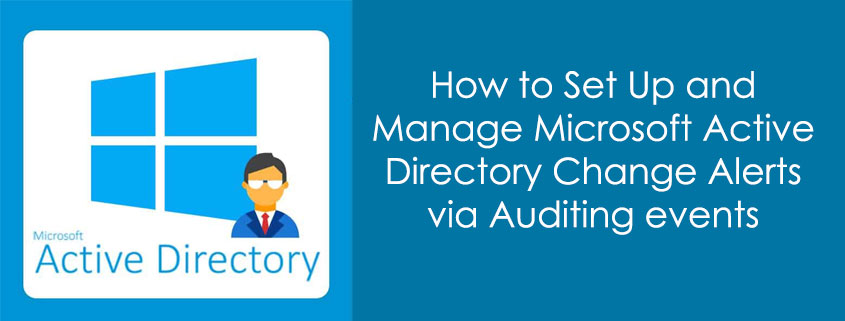How to Set Up and Manage Microsoft Active Directory Change Alerts via Auditing events
Microsoft Active Directory (AD) is one of the most critical controls involved in controlling users, computers, and other more resources in a Windows environment.
Maintaining security and ensuring things keep running at peak operational efficiency requires monitoring any changes to your AD configuration.
One of the primary means of ensuring you are aware of changes to your Microsoft Active Directory is through change alerts.
This article would guide you on how to configure and monitor Microsoft Active Directory change alerts in your system to ensure integrity and security.
Why Do I Need Microsoft Active Directory Change Alerts?
Microsoft Active Directory change alerts are necessary for several reasons; following are a few of them:
- Monitoring Security: AD is the central hub of your organization’s identity and access management. Unapproved change of AD objects such as users, groups, and computers, etc., pose serious security threats.
- Compliance: There are various sectors with specific regulations and laws (for example, GDPR, HIPAA) which require recording and auditing changes in user permissions or access levels. Failure to audit these changes will attract punishment.
- Operational Efficiency: Change tracking helps identify problems that may cause operational inefficiencies, such as accidental deletions or alterations of critical user accounts.
Requirements to configure AD Change Alerts via Audit events
Before you begin to implement AD change alerts, you should have:
1. Requirements for Microsoft Active Directory Change Alerts: Audit Policy Configuration
Proper auditing policies will be required by Microsoft Active Directory when capturing the made changes. The Audit Policy should be configured for captures of the creations, deletions, and modifications of AD objects.
2. Suitable Privileges
Administrative privileges will be required while setting up the auditing settings and while managing alert configurations in Microsoft Active Directory.
3. Trying get changes and reporting via audit events can be complicated as there are many events are generated for changes of each object, to simplify it you may need a SEIM solution to consolidate these events and report. Further AD doesn’t generate events for “All” types of changes. So, some changes may not even show up in change events. We will discuss more on it after talking on how to setup the auditing.
How to Set up AD Change Alerts
Step 1: Configure Audit Policy
To configure AD change alerts, first, you need to configure your audit policies. This can be done the following way:
1. Open the **Group Policy Management Console (GPMC)**.
2. Navigate to **Computer Configuration** > **Policies** > **Windows Settings** > **Security Settings** > **Advanced Audit Policy Configuration**.
3. Expand **Audit Policies** and go to **Directory Service Access**.
4. Set the policy to **Audit Success and Failure**. It will follow both successful and failed attempts to change AD objects.
5. Assign the policy to the target OUs or domains.
Note: to simplify the above procedure you can use CionSystems GPOManager and also Active Directory Manager Pro to setup auditing for all AD objects.
Step 2: Configure Auditing for AD Objects
Now that the audit policy is set, the process is complete as far as enabling auditing of specific Microsoft Active Directory objects:
1. Open the **Microsoft Active Directory Users and Computers (ADUC)**.
2. Right-click the domain or OU you are interested in monitoring and select **Properties.
3. In the **Security** tab, select **Advanced**
4. Choose the **Auditing** tab and then select **Add.
5. Identify the user or group you wish to audit-for example, Everyone or specific administrative accounts
6. Indicate what kinds of changes you wish to be alerted to: **Create**, **Delete**, **Modify,**, or **Move.
7. Apply settings.
Step 3: Set up Alerts in Event Viewer
Now, having auditing enabled, you will need to configure alerts so that you are notified when the following events take place:
1. In Event Viewer, on the domain controller, navigate to Windows Logs > Security
3. Locate the Event IDs used for AD modification events. For example, Event ID 5136, which is used to report changes to an object
4. Create a custom view to filter and include those events. Right-click Custom Views and click Create Custom View.
5. Enter the event IDs you want to be notified for (in this example, 5136, 5137, 5138).
6. Save the view and give it a name.
7. You can also set tasks to e-mail or run scripts whenever these events are logged. To do this right-click on any event, then click Attach Task To This Event and step through the wizard.
Step 4: Using Third Party Tools for more advanced alerting
Even using native tools like Event Viewer, it only configures basic alerts. Third-party tools can offer much more functionality by:
Offering **real-time alerting**-the moment anything changes. Like we previously mentioned not all changes will generate events, so relying on events,; you may miss changes to AD.
CionSystems Change tracker offers **extended reporting**-true reports of AD changes that could be handy for auditing purposes and know who when where and what that is essential for security and compliance and easy affair to manage-domains and other controllers from one centralized management point.
CionSystems Active Directory Change notifier** is a Powerful, in-depth change tracker across Microsoft Active Directory and compliance reports. It has the ability to track “all” changes, even those for which “auditing” doesn’t raise any events, report and send alert at real time. The solution further complements and provide the same functionality for Microsoft Entra ID | Microsoft Office 365.
Best Practices for Managing AD Change Alerts
Review Alerts Periodically or setup filters to get immediately notified for “risky” or “critical” changes
It is through reviewing the AD change alerts that you would be in a position to note any abnormal activities. Ensure that you check:
Critical changes: Monitor for the modification of highly privileged accounts, like Domain Admins.
Failed modifications: Be mindful of failed modifications to AD objects as potential indicators of malicious activity.
Unusual changes: Validate that all modification made are legitimate and authorized
Adjust Alert Sensitivity
Too many alerts can be overwhelming while too few can have you miss the forest for the trees. You need to dial in your alert sensitivity based on the following factors:
– High-priority alerts: Alert for changes on critical objects that include domain controllers, admin accounts, and sensitive security groups.
– Lower-priority alerts: For not critical objects, minimize the frequency of alerts such that they avoid alert fatigue.
– CionSystems change notifier: You can set filters and policies to get notified for only critical changes, there by reducing the number of alerts in your inbox to review. Further, you can mark group policies to eb disabled newly created GPO’s until you review and approve there by stopping the ransom ware in their tracks.
Industry Regulations Compliance
Comply your Microsoft Active Directory monitoring strategy with industry regulations. This can for example be:
– GDPR: Log changes made to user account, groups, GPOs, critical computer or permissions.
– HIPAA: Audit access to protected health information and monitor alterations made to AD objects that are associated with such information.
Compliance audits will frequently need a good amount of activity and change logs. The alerting system should be set to provide this information.
Train IT Staff
It is critical for IT staff to take actions on critical alerts. CionSystems tool set makes it easy to remediate.
Conclusion
Proper setup and change control and real time alerting for Microsoft Active Directory is critical to maintaining the security, compliance, and operational efficiency of your IT environment. Remember AD is tha bank fo all digital keys of the enterprise, a breach of AD means everything in enterprise is compromised. It is critical to be notified of important changes in a timely fashion and respond accordingly.





